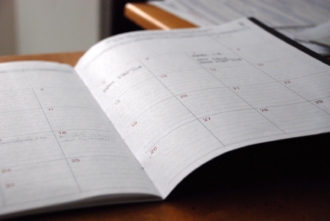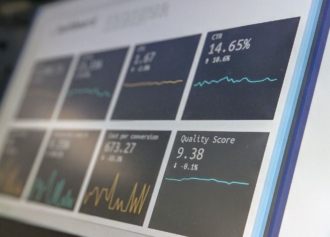There is a horror story out there.
Man is feeling overwhelmed, begins compiling a to-do list.
Three bullets turn into ten — ten bullets turn into twenty.
Moments later, he finds himself in hand-to-hand combat with a to-do list so long and so vast it resembles the spiraling tentacles of a giant squid.
He loads himself up with enough caffeine to fuel an entire city and begins his slow tedious descent to the bottom, crossing each line off the to-do list one at a time.
Shortly into his battle, he makes a terrifying realization — the to-do list is like a regenerating monster right out of a terror flick — for each line he crosses off another three lines appear at the bottom.
He screams. He jumps out of his office window. Thankfully he is on the first floor so he essentially just steps into a large shrub scaring a small family of opossums.
As he begins to sob hysterically, he hears the unraveling of the wretched to-do list drawing ever closer. He turns, it envelopes him, then pulls him back into the deep dark depths of his office.
He is consumed by the monster of his own creation.
It’s a race to the bottom, except there is no bottom.
Nearly all of us have fallen victim to the to-do list at least once in our lives.
After all, the go-to piece of advice we’ve been told since grade school during feelings of overwhelm is, “Make a list and start crossing things off.”
While it sounds lovely in theory, once we set off on our to-do writing journey, we quickly discover a major problem.
In our race to the bottom of the list, we realize there is no bottom.
This fascinating phenomenon, along with a handful of others (which I will discuss in more detail shortly), is what makes to-do lists so incredibly unproductive.
At Jotform, we approach to-do lists with caution, too. After all, we can not and did not rely on to-do lists for many Jotform launches; like HIPAA, Summer Camp or PDF Editor.
Let me explain.
We are terrible at estimating how long tasks take.
Elon Musk is arguably one of the most brilliant minds alive today. Yet, even he has an issue with underestimating how long a task may take.
Time and time again, Elon has set a date for the release of a new model or a production number. And, time and time again, he has missed the deadline.
In an interview he did with The Washington Post he said, “I think I do have, like, an issue with time… I’m a naturally optimistic person. I wouldn’t have cars or rockets if I wasn’t. I’m trying to recalibrate as much as possible.”
If you were to ask Elon’s brother Kimbal, this complicated relationship with time has been present since childhood.
As children, Kimbal Musk (who currently sits on Tesla’s board) would actually lie to his older brother about the time the school bus would arrive — knowing that Elon would show up late.
I hate to break it you, but Elon isn’t the only adult alive today that grew up missing the bus and still suffers from lingering time estimation problems:
A recent study found that only 17% of the population can accurately estimate the time something will take.
With to-do lists what happens is that we optimistically assume most of the day’s tasks will take less time than what they’ll actually take.
And, in our caffeine-fueled to-do-list scribbling, we load up the day with lengthy tasks we “think” we can get done in a few minutes.
This, of course, causes the to-do list to “roll” into tomorrow… which brings us to my next point.
To-do lists are never quite done (some almost always “roll” into tomorrow).
No judgment. But, when was the last time you actually crossed everything off your to-do list?
In addition to horrible time estimation, the reason to-do lists roll into the next day is they place us into a mindset where everything must go on the list — regardless of the level of impact it has on our day.
Or, how much value it adds.
In many ways, to-do lists cause us to be overly proactive in our thinking. Which, in turn, causes us to put a greater emphasis on tasks that — in the broader scheme of things — aren’t that important.
In addition, they also hinder us from feeling a sense of completion with our day and our work.
Nobody that trudges home with a half-completed to-do list feels like they owned the day. No, instead they feel like the day owned them.
To-do lists allow us to avoid the important.
To-do lists also allow us to avoid the most important tasks of the day — they aren’t unlike email in that way.
Take a look at the to-do list I put together below as an example. Let’s pretend it belongs to a sales professional that works for a technology startup.
To-do List:
- Get email inbox to zero.
- Catch up on Slack messages.
- Follow-up with Paul about lunch tomorrow.
- Meet with the marketing team for “brainstorming” session.
- Stop by the grocery.
- Make ‘50’ cold calls to potential leads.
- Do a couple loads of laundry.
- Clean the house.
Now, it doesn’t take a productivity guru to recognize the most important task on the list above is to “make ‘50’ cold calls to potential leads”.
While sure, cleaning the house, doing the laundry, grabbing groceries, following-up with Paul and managing your email inbox might be nice… they aren’t going to create the most impact for the day.
However, if you’re a sales professional (where you get paid to make sales) you better make sure you’re knocking out your 50 cold calls for the day.
While certainly not in all cases, many times people use to-do lists to avoid doing the things they don’t want to do.
Which, is unfortunate, considering the things we don’t want to do tend to be the things we actually need to be doing.
The to-do lists’ better-looking brother.
Scheduling works differently for everyone. If to-do lists work well for you, keep doing them.
However, I would like to offer an alternative. I call it the “hunter” strategy.
Long ago, before we had a fridgeful of food within arm’s reach at all hours of the day, people survived by hunting.
If the hunter made a successful hunt for that day, his family would eat. If not, they wouldn’t. It was that simple.
He didn’t have time to check email, attend time-sucking meetings or send follow-up emails. And, he certainly didn’t have time to make to-do lists. No.
He had to wake up every single day with one goal in mind — to make a successful hunt — which was the single most important thing for him.
I think when it comes to scheduling, this is a great mindset to have. Instead of writing down dozens of tasks that you need to get done each day… choose one that MUST get done and will deliver the most impact.
In Gary Keller’s best-selling book, The One Thing, he argues that:
Long hours spent checking off a to-do list and ending the day with a full trash can and a clean desk are not virtuous and have nothing to do with success. Instead of a to-do list, you need a success list — a list that is purposefully created around extraordinary results.
While this concept might seem a bit abstract, executing it is simple.
You begin by thinking about the one thing you can accomplish today that would have the most impact. If you’re having trouble thinking of something I’ll give you a hint — it’s usually the thing you least want to do.
Once you’ve thought about this thing, I recommend buying a fat stack of post-it notes and keeping them in your desk.
When you walk into your office, pull one of those post-it notes out and write down one big high-impact goal you would like to achieve for the day. Stick the post-it note somewhere on your laptop and start working.
Anytime you feel your mind start to wander or the urge to mindlessly check email well up inside of you — stop. Look at your post. Then, refocus on the day’s hunt.
You can always go back to executing other low-priority or operational tasks once you are done with the day’s hunt.
Practice this strategy for a couple weeks with the goal to cross off the one thing on your post-it note each and every day.
Once the few weeks are up, stop and reflect. Do you feel more fulfilled? Do you feel like you’re making more of an impact?
If the answer is yes, keep on hunting.















Send Comment:
14 Comments:
More than a year ago
If you make a to do list that looks like the example above, of course it won’t work. The key is breaking up tasks into workable goals, and put the most important item on top. Any nuerodivergent person whose tried to find ways of getting work done that works for them would tell you that. Lists are about the only way many adhd people get through their day without shutting down from the amount of things racing through their brains.
More than a year ago
Although having a list of "thigns you've done successfully is a good idea, I think it's also important to have a to-do list.
The problem with this article is, we don't live in the Caveman Days anymore.
Bruh it's the 21st century, me a student for example has so many stuff to do.
I definitely need a to-do list.
I just did a research today on why I should use a to-do list and found so much benefits on them.
To-do lists help help you mentally.
To-do lists help you organize your thoughts
To-do lists help you Prioritize deadlines
To-do lists help you remember important ideas!
To-do lists help you build habbits
To-do lists provides you with a focus and a direction
To-do lists helps you recognize that you amde progress.
To-do lists helps you break down your long-term goals into small achievable goals.
To-do lists also keeps you motivated.
To-do lists saves you time from procrastinating, and helps you know what to do next right after completing one success.
To-do ists make you accountable
To-do lists help relieve stress
To-do lists keeps you from being overwhlemed
To-do lists helps you grow.
PEACE
So anyways, Guys, if you are thinking on using a to-do list, defnitely go for it! Don't let this article discourage you.
More than a year ago
The trick to actually knocking things off your to do list and get to the bottom of it is to break down each item into a workable task. It's true humans are generally terrible at estimating how long things will take, but that's partly because we don't always break it down.
Take cleaning as an example from the article. That's way too broad. Scrubbing the tub, wiping down counters, clearing the bedside table, those are all small enough to fit into a break or a free evening. Same with make 50 sales calls: aim for 5-10, and you'll get it done.
More than a year ago
Excellent! Thanks for sharing that wisdom!
More than a year ago
Interesting idea, except it falls down for me in one big respect.
"Instead of writing down dozens of tasks that you need to get done each day… choose one that MUST get done and will deliver the most impact."
And to choose one you must have a record of it. I've not got a good enough memory to remember everything I need to do in projects or daily life, so I need some "note" or "list" approach to recording what I MUST get done. That is a list in itself so even if you want to do away with lists, you are still referencing a list to recognise what "things" you have the option of doing/ choosing from. Unless I've got this wrong, the article would be better titled "apply the pareto principle to your lists", not do away with to do lists. It's the skill of recognising what "must" be done or which gives the maxium return for least effort which is crucial, not the method by which you record what needs to be done - unless that list is linked to time, in which case let's talk about using Calendars in stead of todolists. Thought provoking read nevertheless. Thank you.
More than a year ago
nothing works better than writing it down on paper
More than a year ago
I liked this article, and naturally my to-do lists, after keeping a journal everyday since two years ago (my journal includes things I have to get done) have went in this direction. Now if I could just figure out why there are things that I want to do, and things I don't want to do, because if you think about it, they're all things I don't want to do, so there really isn't a reason why I like one over another.
Also, @Dian, you help change the culture to work on shared priorities. This is something I work on with my teams as an Agile Coach. :)
More than a year ago
It sounds so easy when you put it that way :D I have the same trouble as Dian - constant interruption and no deputy to help with my own to do list. Sometimes it feels like 50% of the things on my list are the one with the most impact. Something that's really helped me is the GTD method. It's a bit more involved than "hunting" but it helps with the constant influx of stuff.. I've set it up to work in Zenkit (a tool I use every day and the company I work for) and it's been great so far!
More than a year ago
TODO lists are fine, you just need to prioritize and be okay with not completing everything on them.
More than a year ago
How does the hunter strategy work when one works in a space that is easily accessible to others, and literally every 20 minutes someone is seeking your help to deal with their "very urgent" matter that has nothing to do with the goal that you need to accomplish today? Teamwork is desirable and is encouraged but when you are the "go to" person in the office but hardly anyone is equipped or available to help you with your task that you need to accomplish, but you have used your time to help them with theirs...what next?
More than a year ago
I couldn't agree more on this. A simple to-do list can easily grow into an overwhelming list in just 15 minutes. However, as a project manager who deals with tons of tasks everyday, a to-do list still remains a must-have for my work. I can dump all the ideas that my team and I have generated and brainstormed together then organize them into a tree-like structure. Looking at a hierarchical list with context can let me visualize my plan and project easily.
However, as you said, the key to success is to get focused. A while ago I found on the internet a very good article on this issue:
They carefully explained how you need to pick up (hunt) a few tasks and move them from the task list to a board, so that you only focus on the things that actually matter for a short amount of time.
The fact that some productivity tools, like Quire - the software my team is using right now, realized this methodology and implemented it seamlessly, always amazed me.
More than a year ago
At home and work I write to do list. I don’t note how long it should take to accomplish each task/reminder because I’m not making appointments, writing down things I need to do so I don’t forget them. Really important things I sometimes write on post it’s and put in a conspicuous place.
More than a year ago
Well it depends whether you are a man or woman I guess if we start by gender. Not all "successfull" and "not successfull" people do To Do List, but some do. It's a matter of listing down your Big Rocks vs Small Rocks. It's priority scale. Me - myself - is absolutely enjoying everymoment writing down everything on my notes. It relieves what's on your mind and practises your hand sensors,and nerves. Most importantly we don't always have to replace everything with electronic or apps.
More than a year ago
While I agree with choosing ONE thing, I use lists effectively with Workflowy - because it is easy to prioritize - a paper to do list is a nightmare.